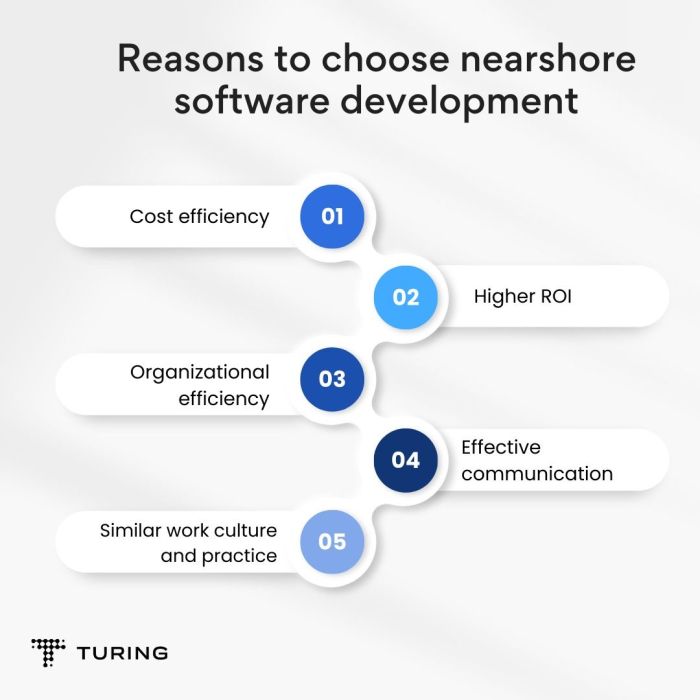Nearshore software development for desktop apps – In today’s interconnected world, businesses are leveraging technology to improve efficiency and streamline operations. One of the most impactful strategies is nearshore software development, especially for desktop applications. This article explores the ins and outs of nearshore development, its benefits, challenges, and best practices.
What is Nearshore Software Development?
Nearshore software development refers to the practice of outsourcing software development tasks to companies or teams located in nearby countries. This approach allows businesses to take advantage of geographical proximity, similar time zones, and often cultural affinities.
- Geographical Proximity: Nearshore partners are usually located in neighboring countries, making it easier for companies to communicate and collaborate.
- Time Zone Alignment: Working within similar time zones facilitates real-time communication and quicker turnaround times.
- Cultural Similarities: Often, nearshore locations share cultural and business practices that streamline collaboration.
Why Choose Nearshore Development for Desktop Apps?: Nearshore Software Development For Desktop Apps
Many companies are turning to nearshore development for their desktop applications. Here are some compelling reasons:
1. Cost Efficiency
Outsourcing to nearshore locations can significantly reduce costs without sacrificing quality. Here’s how:
- Lower labor costs compared to domestic developers.
- Reduced overhead expenses associated with in-house development.
- Flexibility in scaling teams as needed.
2. Access to Talent
Nearshore locations often have a strong pool of skilled developers qualified to work on desktop applications. This talent access includes:
- Developers with expertise in various programming languages and frameworks.
- Teams experienced in the latest technologies and methodologies.
- Availability of specialized skills that may be scarce in your home country.
3. Faster Time to Market
The geographical and time zone proximity allows for quicker communication and project turnaround. Benefits include:
- Real-time collaboration for rapid iteration and feedback.
- Ability to address issues promptly, preventing project delays.
- Efficient workflows that enhance productivity.
Challenges of Nearshore Software Development
Despite its advantages, nearshore software development is not without challenges. Here are some common pitfalls:
1. Communication Barriers
Even with cultural similarities, language barriers can still pose challenges. It’s essential to:

Source: thehotskills.com
- Establish clear communication protocols.
- Utilize collaboration tools that facilitate documentation and discussions.
2. Quality Assurance
Maintaining quality standards across teams can be tricky. Consider implementing:
- Regular code reviews and testing procedures.
- Utilizing standardized project management tools.
3. Time Zone Differences
Even slight discrepancies in time zones can affect collaboration. Strategies to manage this include:
- Setting overlapping work hours for meetings.
- Using asynchronous communication tools effectively.
Best Practices for Nearshore Software Development
To maximize the benefits of nearshore development, consider these best practices:
1. Define Clear Objectives
Before engaging a nearshore partner, ensure that you have well-defined project goals, timelines, and deliverables. This clarity helps in:
- Avoiding misunderstandings.
- Aligning expectations between your team and the nearshore developers.
2. Build Strong Relationships
Cultivating a strong working relationship with your nearshore team is crucial. Focus on:
- Regular check-ins and progress updates.
- Fostering an inclusive culture where all team members feel valued.
3. Utilize the Right Tools
Adopting effective collaboration tools can significantly enhance productivity. Consider using:
- Project management software (e.g., Jira, Trello).
- Communication platforms (e.g., Slack, Zoom).
- Version control systems (e.g., Git).
Frequently Asked Questions (FAQs)
1. What are the primary benefits of nearshore software development?
The main benefits include cost efficiency, access to skilled talent, and faster time to market.
2. How do I choose a reliable nearshore development partner?, Nearshore software development for desktop apps
Look for firms with a proven track record, positive client testimonials, and a culture that aligns with your business values.
3. What types of desktop applications can be developed nearshore?
Nearshore teams can develop various desktop applications, including productivity tools, customer relationship management (CRM) systems, and specialized industry software.
4. How can I ensure quality in my nearshore development project?
Implement regular quality checks, maintain open communication, and set clear standards for deliverables.
5. Is nearshore development suitable for small businesses?
Yes, nearshore development can be particularly advantageous for small businesses seeking to lower costs while gaining access to high-quality development resources.
Conclusion
Nearshore software development for desktop applications presents a viable solution for businesses looking to enhance their technological capabilities while managing costs effectively. By understanding the benefits, challenges, and best practices, you can make informed decisions that propel your projects to success.

Source: cloudfront.net
If you’re considering nearshore development for your desktop application, reach out to us today for a consultation. Let’s explore how we can help your business thrive in the digital landscape!
FAQ Section
What are the main benefits of nearshore development?
Nearshore development offers advantages such as cost savings, improved communication, and cultural alignment, all of which enhance project outcomes.
How does time zone difference impact nearshore development?
Time zone differences are minimal in nearshore development, facilitating real-time collaboration and quicker feedback loops compared to offshore options.
Is nearshore development suitable for all types of projects?
Yes, nearshore development can be tailored to fit a wide range of projects, from simple applications to complex systems, depending on the team’s expertise.
How can I ensure the quality of the nearshore development team?
Researching their portfolio, client testimonials, and conducting interviews can help ensure the quality of the nearshore development team you choose.
What tools are commonly used in nearshore software development?
Common tools include project management software, version control systems, and communication platforms, which facilitate collaboration and efficiency.
